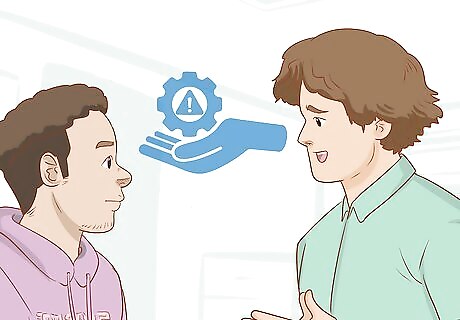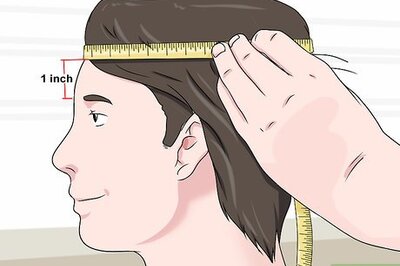
views
Stay calm.

Getting worked up probably won’t help fix any mistakes. It’s easy to feel angry or upset when someone messes up, but try to keep your cool. If you need to, take a few minutes to calm down before you talk to someone about what happened. Take some deep breaths, count to 10, and lower your stress levels for a more productive conversation. This is especially important if you’re in a workplace setting. Flying off the handle isn’t professional, and you want your coworkers or employees to see how well you handle a slip-up.
Start the conversation with a positive.

Get the conversation going on the right foot. When you first approach someone who has messed up, tell them something good about their work ethic, their performance, or their behavior. That way, the impact is slightly lessened when you bring up the thing that they did wrong. You could say: “Hey Mark! I really appreciate you getting those reports on my desk so quickly.” “Allison, it’s good to see you. You’re always so punctual, and I’m really grateful for that.”
Bring up the mistake with curiosity.

Curiosity opens up a conversation rather than a confrontation. When you bring up the mistake that was made, phrase it in a way where you’re simply gathering information, not blaming or shaming anyone. That way, the other person has a chance to explain themselves, and you can understand their motivations a little better. Try something like: “I’m a little curious as to why you didn’t include the statistics in your latest report.” “Would you mind explaining why this client’s account is closed?”
Be straightforward about the mistake.

Beating around the bush tends to make things confusing. After you’ve brought up the mistake, spell it out clearly so there’s no confusion. Try not to be mean or rude about it, and just state the facts—that way, everyone’s on the same page. “It looks like the numbers from last quarter were not included in this report, which skewed all the data.” “Since the reports were turned in late, we lost a large client.”
Criticize the mistake, not the person.

Don’t make the other person feel bad about themselves. Everyone makes mistakes, so you don’t need to tell someone that they’re a terrible employee or a bad coworker. Focus on what happened, not the other person’s work ethic or intelligence. Instead of saying, “If you didn’t rush so much, you would have caught this,” try, “I think that some errors were left in, which made our company look a little sloppy.” Instead of saying, “You need to be more personable and friendly,” try, “By using different phrases and a kinder tone, you can make your clients feel more at ease.”
Ask why or how the mistake was made.

Give the other person a chance to explain. If you know how the mistake was made, you can try to prevent it from happening again in the future. When you ask, be careful not to assign blame, and let the other person know that you simply want information. “Could you explain how this slipped through the cracks?” “Can you walk me through what went wrong here?”
Listen to the other person.

Try not to interrupt them so they feel like their voice is heard. Listening to them will make it feel less like an accusation and more like a conversation. Plus, then you can both work together to correct the mistake and move forward. Make eye contact and nod along with them to show that you’re listening. Ask follow-up questions like, “Can you tell me more?” or, “I’m not sure I understand. Could you explain that?”
Offer constructive feedback.

Phrase your criticism in a helpful way to avoid blaming or shaming. You might have some pointers that you can share for next time, so do your best to offer suggestions instead of barking orders. If you present your criticism in a constructive way, it’s much more likely to come across as kind and helpful. “In the future, I’d suggest dedicating 1 hour per day to this task. That way, you don’t have to rush to finish it at the end of the week.” “Maybe next time you could check in with a coworker if you don’t understand something.”
Explain how the mistake can be corrected.

There may be a way for the other person to fix what they did wrong. If that’s the case, explain it to them gently but firmly, and walk them through the process if they’re confused. That way, they can feel good about correcting their mistake, and they also know what to do (and what not to do) for next time. “What you can do is just go in and add the statistics from this quarter. That way, the report will be accurate.” “All you need to do is call the client and ask them to reschedule.”
Offer to help, if you can.

Take some of the responsibility so it’s not all on the other person. They’ll probably feel less embarrassed or defensive if they see you working hard to help them out. If you’re able to, give them a hand and help correct their mistake as quickly as possible. “I can go ahead and help you out if you need it. You just let me know what I can do, okay?” “I’ll take the first half, you take the last half. If we work together, we can bust out these reports by Friday.”
Turn the issue into a teachable moment.

Mistakes are a great way to ensure something doesn’t happen again. Try to find the overarching lesson within what happened, and focus on that as you wrap up the conversation. Remind the other person that it’s okay to make mistakes, and that the only way forward is to move on. “Well, at least now you know! You probably won’t be making that mistake again, huh?” “Even though the reports got messed up, at least you know how to enter in those statistics now!”



















Comments
0 comment